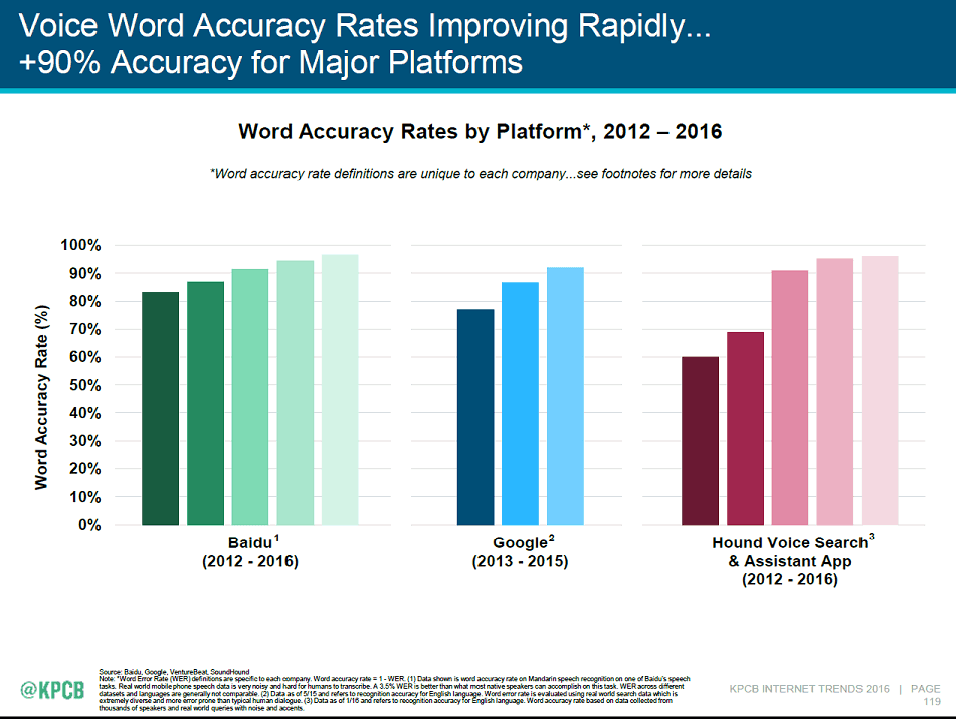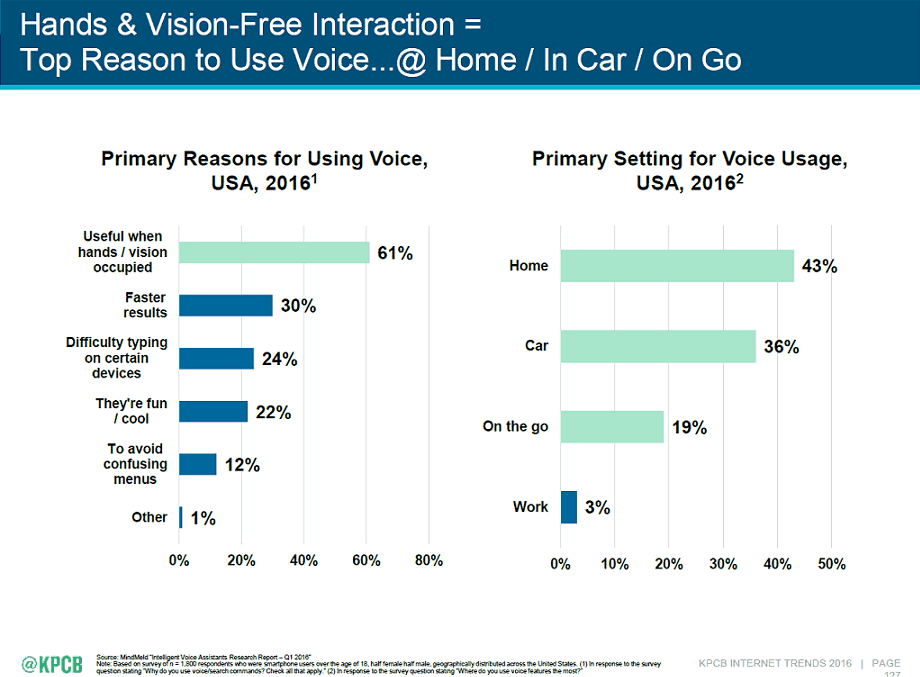Voice Search Statistics, Facts, and Trends 2019 For Online Marketers
Can you hear me now? There is no doubt that voice search has arrived and is here to stay. Voice engagement presents a challenge for online marketers.
However, the point of this article is to dive into voice search statistics for 2019 and see if, in fact, someday you may very well need to say things just like that. (hint, you will, and sooner than you think).
Voice search in 2019 is significant and growing, but as it stands, traditional search application remains strong.
Based on the rising trend in vocal search stats from 2018, we have more than enough evidence to realize where this show will next travel. Voice search growth is continually being debated, as well as being embraced.
Online Marketers now understand that voice searches matter, and they are taking the time to adapt their online business before they get passed by.
No longer the perceived subplot of some science fiction narrative, it is quickly becoming embedded into the traditional American family’s daily happenings.
– 58% of consumers have used voice search to find local business information within the last year.
– 46% of voice search users look for a local business daily.
– 27% visit the website of a local business after conducting a voice search.
– 76% of smart home speaker users conduct local searches at least once aweek—with 53% performing daily searches. Source: BrightLocal Study
– 1 in 5 adults uses mobile voice search at least one time a month, according to Global Web Index.
– 22% of smart home speaker owners have made a purchase using their device. (Edison Research)
– 2 of 5 adults perform a voice search at least once a day. (Location World)
Feel free to use my infographic on the growth of voice search, with a link back to this article.
Local Voice Search, Be Prepared
Voice search and local search go together like a toddler’s hands and mittens. In my recent local SEO service trends and tips for 2019 roundup with industry experts, local voice search was a common theme.
Consumers are being trained by the likes of Amazon and Apple to just shout out their needs and expect expedited local solutions to accommodate them.
People are not afraid of the machine anymore; they have gone beyond a period of discomfort and hesitance and into a place of comfort and instantaneous gratification. When we consider the full scope of voice search, we eventually break it down to a consumer being able to gratify a search need without ever having to pull away from decorating the Christmas tree.
The question for online marketers has now become, “will my goods or services fill the need?”
Voice search optimization is a hot topic that I will break down in another article.
It is most certainly a question many online marketers are now asking themselves and maybe even aloud.
Local voice search is an interruptive consumer behavior based on questions and answers that are changing the way traditional optimization is approached.
Many SEO’s are finding themselves shell-shocked by a conventional search disfigurement and scrambling to adapt. Technology, search engines included, move with furious and reckless paces that often leave unattentive digital marketers in pandemonium.
The good news is, you are not late for the inauguration of your adaption process into voice search. However, the clock is ticking which means the time is now to better adjust to an apparent future that is local voice search.
So, can you hear me now?
Voice Search Stats Updated Jan. 2019
Voice searches are increasing in volume at a tremendous rate.
According to Mary Meeker’s annual Internet trends report, which was posted by SearchEngineLand last June, displays that voice search queries are now 35 times larger than they were in 2008. 2008 is widely considered the launch of voice searching technology.
50% Of All Searches Will Use Voice By 2020
Further feeding the beast is a statistical search analysis by ComScore which predicts that 50% of all searches will be accomplished by voice search in 2020.
That is only four years away. In other words, if the ComScore analysis is correct, in a mere four years, your business will either begin its ascent into financial bliss or sink into Internet oblivion as a dinosaur, depending on its voice search optimization.
If you spend the next couple of years not regarding voice search as a massive cultural change, you are likely investing in your own demise.
Voice Search Growth Driven By Device Saturation
Searching on Siri when it first came out in 2011 on iPhone 4S was hardly a sophisticated undertaking.
At the time many dismissed that growth was of any valid concern.
Siri was innovative and fun, but often your searches were misinterpreted, leading to all types of inappropriate results. “I said tool stores near me, not pool tours beer me!”
I have to believe that a great many searches were performed out of a user’s fascination with the concept and less as a desire for useful search results.
Initial fascination with voice technology capability was often short-lived for some people who did not quite enjoy the technological growing pains. However, innovation and advances were quick to remedy blundering Siris one IOS update after another.
Apple was sold on it being the future which led them to an unwavering focus on the advancement and refinement of the technology.
It was not long until Siri’s microscopic pin sized ear was better than your grandmother’s and more sophisticated than your coworker’s.

Image Credit: KPCB 2016 Internet Trends
Google Home Search Data
Back in 2013, Google was not much better than Siri’s debut blunders. In Meeker’s statistics, Google voice capture ability was around 78%.
That may sound high, but the inability to competently capture 20% of a surfer’s voice commands is a recipe for confusion. Google is now above the 90% marker in voice search capture ability and likely headed towards near 100%.
Voice capture technology is almost as reliable as a keyboard search on the Google search traditional platform.
More and more consumers are figuring out that voice search can help them lead simpler lifestyles. The concept of being enslaved by a machine is driving more people than ever to devices which seemingly offer such freedoms.
You no longer have to leave the room during the Cowboys game to grab your laptop to search for a local pizza delivery service. You do not have to look down at your smartphone and navigate a browser while fat thumbing a search for “Starbucks near me.” You can quickly order more diapers while changing a dirty one. Mobile marketing will never be the same.
Google has stated that 20% of all searches are voice related. And Google search statistics regarding voice most certainly entice, and maybe shock, the most successful Internet marketers.
While it is all impressive and astounding, it indeed isn’t surprising.
There are several driving factors in the meteoric rise of voice search trends. When it comes to voice search statistics in 2017, you can expect this trend to continue to rise into 2019 as more and more people become voice device enabled.
Pandora’s box has been opened; the likes of Amazon, Apple, and Microsoft are evolving to meet the growing demand for voice-enabled devices. Every holiday season, more and more households become voice search enabled.
So what are the products that serve to reshape search logic as we know it?

Woman using her mobile phone to search by asking a question.
How Many People Use Voice Search Devices?
By the year 2020, Activate predicts that 21.4 hands-free devices will be in homes.
That stat prediction alone should compel any and every marketer in existence to get on board with voice search. But things get even more imperative for marketers with the voice search stats prediction by Voicelabs, who claimed in 2017 that 33 million of these devices would be in circulation. Were they correct?
No, they missed the mark by 12 million. That is to say; their prediction turned out to be short 12 million devices.
In 2017 Q4 alone, 18 million smart speaker devices were shipped out, which brought the overall circulation total to 45 million devices.
When voice search stat predictions are not keeping up with the furious trend’s speed, you know you need to prepare.
The home voice assistant is here to stay.
Every passing holiday season, a new segment of the herd becomes more exposed to the remarkable benefits of having a personal home assistant.
It is indeed changing the way search functions.
What we are seeing is a massive cultural change happening, and if we are not adapting to it, we are falling behind.
There are over 20 million hands-free device activations on the horizon which is prompting online companies to take a serious look at where their businesses are going to fit in.
Someone is going to be cooking and have raw chicken on their hand and suddenly call out “flower shops that deliver,” the question is, will they be exposed to your flower shop or your competitors?
You do not need to understand the ins-and-outs of every hands-free search device to begin your local search preparation. Just accept that voice search will be an expansive, deeply-reliable, and culturally comfortable search method.
If your business is ill-prepared for the influx of massive home assistant technology, you will suffer the dire consequences.
By 2020, 30% Of All Searches Will not Use A Screen
Further adding to the mayhem of changing search behaviors via hands-free devices such as Amazon Alexa, Apple Siri, and Microsoft Cortana is that we are ushering in an era whereas 30% of all searches are done without the use of a screen.
Shut the front door! No, it is happening, people are going to find all their local needs without ever seeing a visual display.
Y0u might consider this statistic to be somewhat underwhelming due to having already read the stats involving overall voice search numbers and device assistant activations stats.
However, as it stands, many people use voice search as a means to bring up search results. In some ways, this is our transitional phase into full-on display-less search existence.
The process remains engrained in using the display to bring up results. Home assistants, however, are getting savvier by the day at working in unison with applications, such as Google maps and checklists, allowing a complete bypass of traditional search results.
It is not a fully-fluid experience yet, but it is coming.
Who Are The Industry Players?
Amazon Echo Was Top Selling Holiday Item
The Amazon Echo is a top-selling personal voice assistant.
With a bevy of marketing campaigns on major network television stations, millions of Amazon Prime users being exposed to the benefits, the Amazon Echo is a massive influence in the voice search market share.
Amazon Echo may be second to Apple’s Siri, but it is not riding in the backseat regarding success. In fact, the Amazon Echo was the top selling product on Amazon.com during the holidays.
Amazon advertises the Echo as a single-function, purely one-dimensional experience.
You call out your request or curiosity and seconds later you stand enchanted awaiting your Uber. They also advertise ease of use with their voice capture technology through Alexa (that is what Amazon calls their Siri).
Because so many people have this perception of bumbling voice capture environments, Amazon aims to curb such inhibitions by painting them as misconceptions.
Amazon takes on this issue, as well as the poor application of voice capture, brilliantly in their ad campaigns.
Google Home, The King Of Voice Marketing
Google Home, while a newer kid on the block (not HomePod new, but still newish), must not be overlooked in the voice search market share conversation.
Google is an early adopter artificial intelligence and machine learning.
Google is Google, and that means massive reach, infinite marketing spends, and almost unrivaled influence over consumers.
Google’s desktop and mobile search are voice capable, as are their calendars and Google Drive documents. Amazon Echo remains the dominating device, but Google remains the earliest adopter with the most influence to expand in the voice search market share.
Google Home is now making a massive push to flood the market and capture a great deal of Amazon’s surging market share. They are doing so by replicating Amazon Echo’s marketing campaigns. They focus on simplicity and freedom.
Apple Siri Is Upgraded And Ready For Mobile Voice Technology
Siri is often camouflaged in a sea of mindless, wasteful apps and absolute necessary functions.
You pick up your iPhone because you need to text your business partner or family member or friend. You need to make phone calls.
Those two essential smartphone functions are already buried underneath of app games and calculators and retail store points apps.
The point being, Siri is often a casualty of functional saturation. Additionally, Siri must be activated by the user to operate, which means you must have the iPhone in hand.
While Siri has been the “rock” of AI voice assistants in the market, the recent uprising in competition by Amazon and Google have cast a shadow over it.
Siri can hold court due to it being the primary personal assistant function on the world’s most popular device, the iPhone. However, it has found itself losing market share due to having to have the iPhone device on hand to use.
This is Apple, and they are about to remedy all of this.
First, it should be noted that Apple recently announced a massive hiring plan for 2019. The new tax plan, Apple’s renewed promise to bring in billions of off-shore dollars back into the states, and their subtle loss of AI market share are all likely contributors to Apple’s plan to expand employees.
Yes, they have billions of dollars and a new motivation to upgrade Siri so you can expect massive technological advances.
Welcome To The Party Apple HomePod
Wait, you thought Apple was just going to rest on their laurels?
Siri’s main weakness and apparent strength both reside in the fact that she is located on the iPhone.
Most people use an iPhone. However, new personal assistants do not require the device to be in hand.
On February 10th, Siri moved into your hands-free living room space.

While many believe they have focused on the music/speaker aspect of the Homepod, it will also serve as a smart assistant.
What could go wrong with the HomePod? Once again, Apple is playing to their extensive following of loyal iPhone users.
If you do not have an iPhone, iPad, or iPod touch, you cannot set it up.
I am not sure if it will be possible to set it up using a MacBook Pro, it seems senseless that you will not be able to. However, there is no confirmation either way.
The HomePod will set up in seconds, but it is not about to allow for non-sanctioned Apple use.
Apple realizes its monstrous market positioning, so it is willing to take a few bumps and bruises in disallowing non-IOS folks access.
Voice Search Stats and Audiobooks?
While it might seem like an odd connection to make, voice search stats and their upward trend are indeed related to growth in audiobook trends.
Comparing both trends is little more than added confirmation to the entire point of this article.
If you are not convinced that your business needs to prepare for voice search, you do not have to look any further than the rising audiobook industry’s stats.
Audiobook usage puts on display computer users comfort level with merely having a book read to them as opposed to reading them off a hardcopy book or tablet.
Audiobooks are the fastest growing niche in the publishing world. In 2017 alone, audiobook providers rang in $2.5 million in sales.
Furthermore, 26% of Americans enjoyed their favorite books via listening to an audio device such as an iPhone or a home assistant. For every person that purchases an Amazon Echo, they will be exposed to the smart speaker’s ability to read books.
This will further develop a cozy relationship between the person and the device, which is sure to claim increases in voice search market share.
Local Search Ramifications Explained
Why is all of this important? Why did we just watch commercials? Why should we, as marketers, how voice search will change SEO?
The answer is that the devil is always in the details. Understanding why consumers are seeking out voice search devices can help us better understand what voice search optimization ramifications these devices will have on SEO. The evolution has arrived, fewer people are typing in their searches, which means that keywords are changing.
People do not speak as precisely as they type.
When someone has a thought, the way that thought is relayed to the world through voice will be different from the way it would have been communicated through typing.
We need to understand why people are using these devices (pay attention to the ads) and how their search terms are being altered.
The annual report by Meeker showed us that 61% of voice searches are the result of someone being occupied.
Just like the Google Home commercial narrative suggest with the busy dad needing information on a recipe, people enjoy the convenience that sophistication voice search has to offer.

image credit: KPCB 2016 Internet Trends
Conclusion Be Prepared for Voice Search Growth
Voice search statistics in 2019 reveal that the future of traditional search behaviors is changing.
As online marketers, we can now see that billions of dollars are flowing into the Artificial Intelligence sector. Smart personal assistants are becoming a part of normal everyday life.
If your online business is not making considerations with voice search, your online business is falling behind. Voice search and SEO is not the next big thing; instead, it is today’s big thing.
By understanding linguistics and paying attention to smart device advertising, we can gain insights into how we may need to adapt our search and online marketing strategy. here to add your own text




